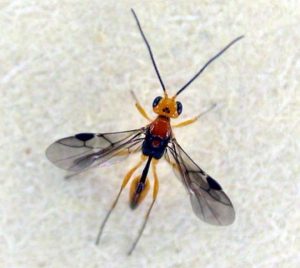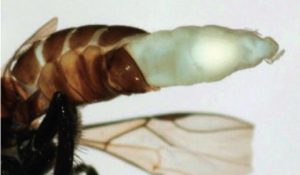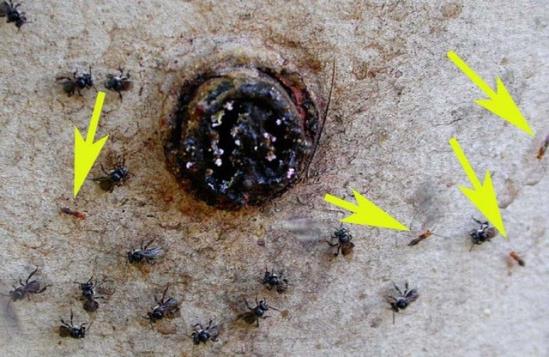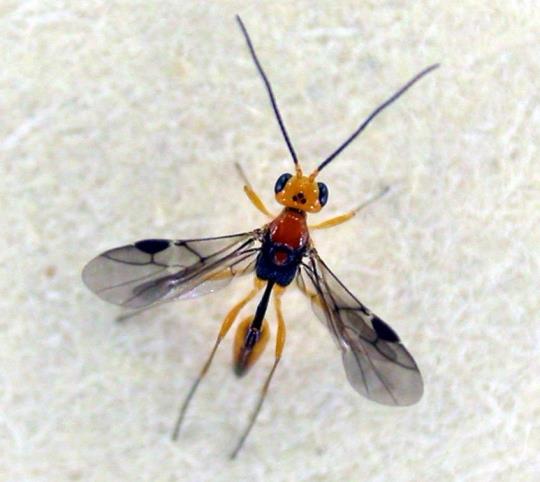Australian stingless bees are parasitized in one form or another by a variety of other insects, including flies, wasps and beetles. In most of these cases it is the bee’s nest, packed with pollen, honey and brood, that is the target. For example, the larva of native phorid flies, syrphid flies and hive beetles all exploit their bee hosts by feeding on the rich stores inside the nest.

One native parasite of stingless bees, however, relies on a particularly intimate relationship with the bees themselves in order to raise its young – the braconid wasp Syntretus trigonaphagus.
These wasps are parasitoids meaning that their larval stage is spent inside the body of their host. This requires a rather remarkable egg-laying strategy by the female wasp. She waits at nest entrances or at flowers for the chance to get close to a worker bee. She then approaches the bee from behind, tucks her ovipositor between her legs and quickly lays an egg on the underside of the bee’s abdomen – a process that takes just a fraction of a second.
When this egg hatches, the tiny larval wasp will bury into the bee and grow inside it, feeding on the bees internal tissues, until it completely fills the abdominal cavity. It then bursts out, wriggles to the ground and digs into the soil where it pupates, eventually emerging as an adult wasp. The host bee, meanwhile, perishes shortly after the larva emerges.

John Klumpp was one of the first to make careful observations of these wasps and their egg-laying behaviours in 2007, and some of his stunning photographs are included here.
There remains a great deal we still don’t know though about these remarkable natural enemies of stingless bees. They were described and identified based on specimens collected from T. carbonaria in S.E. Queensland. But do they equally target other Tetragonula species? And Aus-troplebia? Nature often favours very close coevolutionary relationships between these types of parasites and their hosts, so does each bee species have its own wasp? Simi-larly, are there different wasp species in different parts of the range of Australian stingless bees? Or does the one species occur all across Northern and Eastern Australia?
Answering these questions will require collecting samples of the wasp (either adults or larva from infected bees) from as wide as possible a range of locations and host bee species, and comparing their genetic diversity. Documenting the range and diversity of native bee pests is important, as it provides a baseline for understanding how populations of these pests change in the future, alongside their host bees.
Can you help to provide samples?
Researchers at The University of Sydney are hoping to collect samples of this wasp from across Queensland and NSW to better understand its natural distribution, diversity and relationship to our bees. If you keep stingless bees and are interested in helping out, you can do so by contributing samples to the study. We are looking for samples from all stingless bee species and all regions of Australia!
You can contribute either:
• a direct sample of the wasp or an infected bee (if you observe them), or
• a random sample of 50 exiting foragers (which we will search for wasp larva)
Contact Ros Gloag for more details on how to provide samples: ros.gloag@sydney.edu.au


